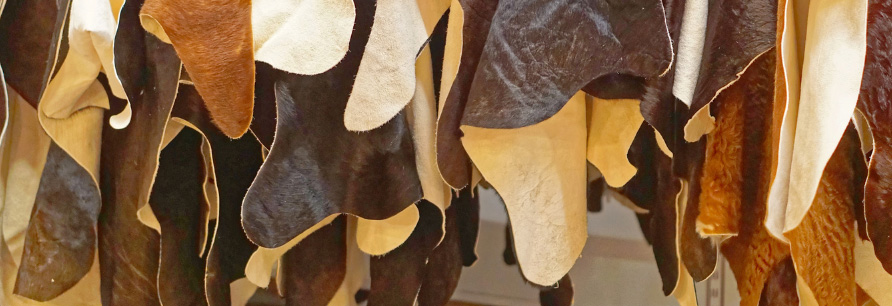
Inspection ensures that the hides meet the required standards and specifications for different applications, ranging from fashion and accessories to upholstery and automotive industries. Here's an overview of the raw hide inspection process:
Initial Assessment: The inspection process begins with an initial assessment of the hides. This involves evaluating factors such as size, shape, weight, and overall condition. Any visible defects or damage, such as cuts, scratches, or blemishes, are noted during this stage.
Grading and Classification: The hides are then graded and classified based on their quality and characteristics. This involves categorizing the hides into different grades, such as full grain, top grain, corrected grain, split leather, and more, as discussed in the previous response. Grading helps determine the appropriate applications for each type of hide.
Measurement and Thickness: The thickness of the hides is measured using specialized equipment. The thickness is an important factor in determining the durability and strength of the leather for specific purposes.
Color and Uniformity: The color of the hide is examined for consistency and uniformity. Any variations in color or dye penetration are noted, especially for hides that are intended to be dyed or treated later.
Tannage Assessment: If the hides have undergone tanning, the tannage is assessed. This involves checking the degree to which the hide has been treated to achieve the desired qualities, such as softness, color, and resistance to moisture and heat.
Record Keeping: Detailed records of each hide's inspection results are maintained. This information helps in tracking the quality of hides, identifying trends in defects, and ensuring consistency in the supply chain.
Inspection protocols and criteria may vary depending on the specific requirements of different industries, manufacturers, and market segments. The goal of equine and bovine hide inspection is to ensure that the raw materials used in leather production meet the desired quality and performance standards for the end products.
Raw hide are processed to create leather, a versatile material used in items such as shoes, bags, belts, furniture, and clothing.
The importation of raw hides is a significant aspect of the global leather industry. Many countries engage in the trade of these hides to meet the demand for leather products worldwide. The import of hides can involve both raw, untreated hides as well as processed leather materials.
Market Demand: The demand for leather products in various industries, such as fashion, automotive, and furniture, drives the import of hides. Countries with strong manufacturing sectors often have a higher demand for these materials.
Quality and Types of Leather: Different animal breeds and hide processing methods result in various types and qualities of leather. Some hides are more suitable for certain applications than others, leading to variations in import preferences.
Full Grain: Full grain hides are considered the highest quality. They retain the original grain of the animal's skin, showcasing its natural texture and imperfections. Full grain leather is often thick and durable, making it ideal for products that require strength and longevity.
Top Grain: Top grain hides are slightly altered from full grain hides. The outermost layer of the hide is sanded or buffed to remove imperfections, resulting in a smoother surface. While this process reduces the natural texture, top grain leather is still of high quality and commonly used in luxury products.
Corrected Grain: Corrected grain hides have a layer of artificial grain applied to the surface after imperfections are removed. This creates a uniform appearance but sacrifices the natural texture of the hide. Corrected grain leather is often used in products where a consistent look is desired.
Split Leather: Split leather is derived from the lower layers of the hide after the top grain has been removed. It is generally thinner and lacks the natural grain texture. Split leather can be further processed and finished to resemble higher quality leather or used in less demanding applications.
Suede: Suede is created from split leather by buffing the inner surface to create a soft, napped texture. While suede lacks the durability of full grain leather, it is valued for its luxurious feel and appearance.
Aniline Leather: Aniline leather is dyed with transparent dyes that retain the natural grain and texture of the hide. This type of leather showcases the inherent characteristics of the material but may be more susceptible to staining and fading.
Semi-Aniline Leather: Semi-aniline leather is treated with a light layer of pigment or protective coating, providing some stain resistance while preserving the natural appearance to a certain extent.
Nubuck: Nubuck is similar to suede, but it is created from top grain leather that has been sanded to create a velvety texture. It offers a balance between the softness of suede and the durability of leather.
Bonded Leather: Bonded leather is made by combining shredded or ground leather with a binding agent. While it contains leather particles, it is often considered a lower quality material due to its limited durability and natural attributes.
Trade Agreements: Trade agreements between countries can affect the import and export of hides. Tariffs, quotas, and other trade policies can impact the volume and cost of hide imports.
Environmental Regulations: The sourcing of hides may be subject to environmental regulations and sustainability considerations. Ethical and ecological factors can influence trade decisions and import practices.
Economic Factors: Economic conditions, including exchange rates and labor costs, can affect the competitiveness of hide imports from different regions.
Cultural and Fashion Trends: Fashion trends and consumer preferences for leather products can influence the types of hides that are imported.
The leather industry and its associated trade in hides have both economic and environmental implications. The processing of hides and leather production can generate waste and pollution, and there is an increasing focus on sustainable and ethical practices within the industry.











